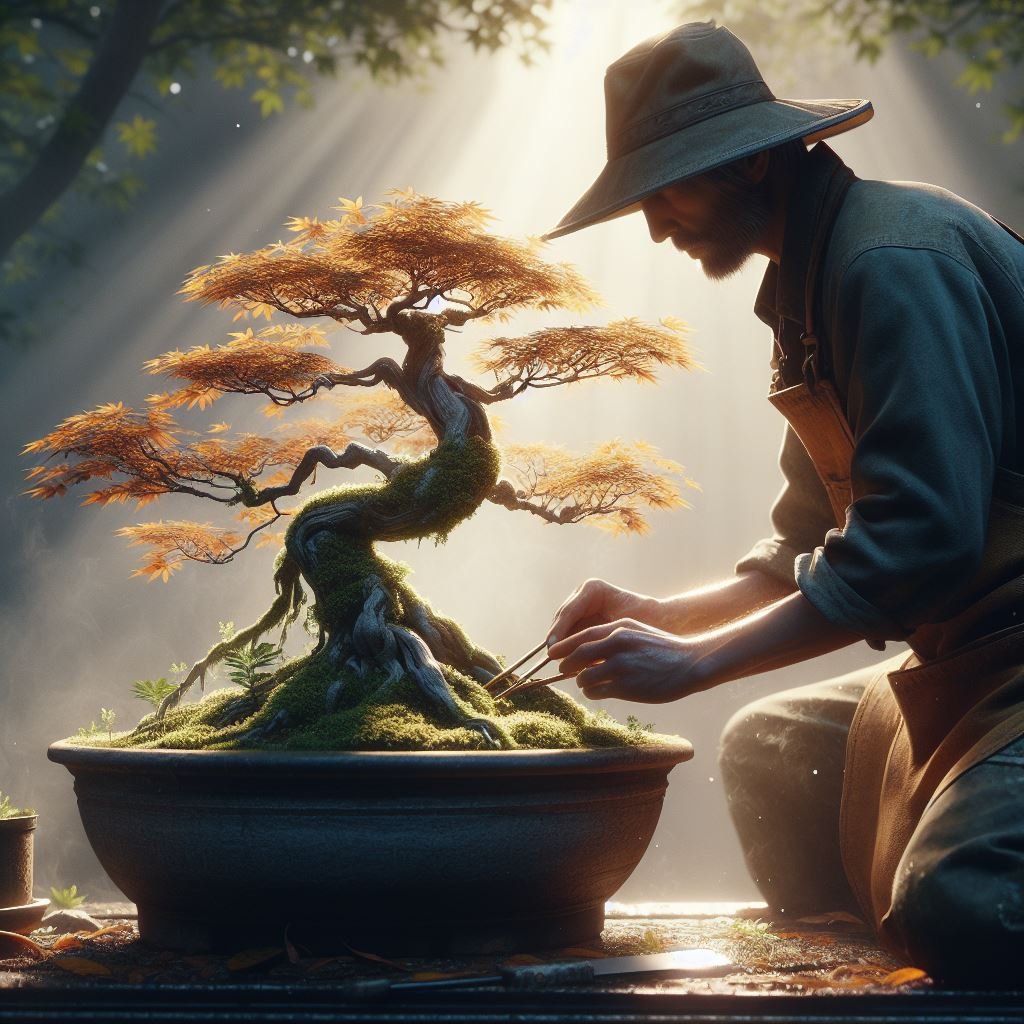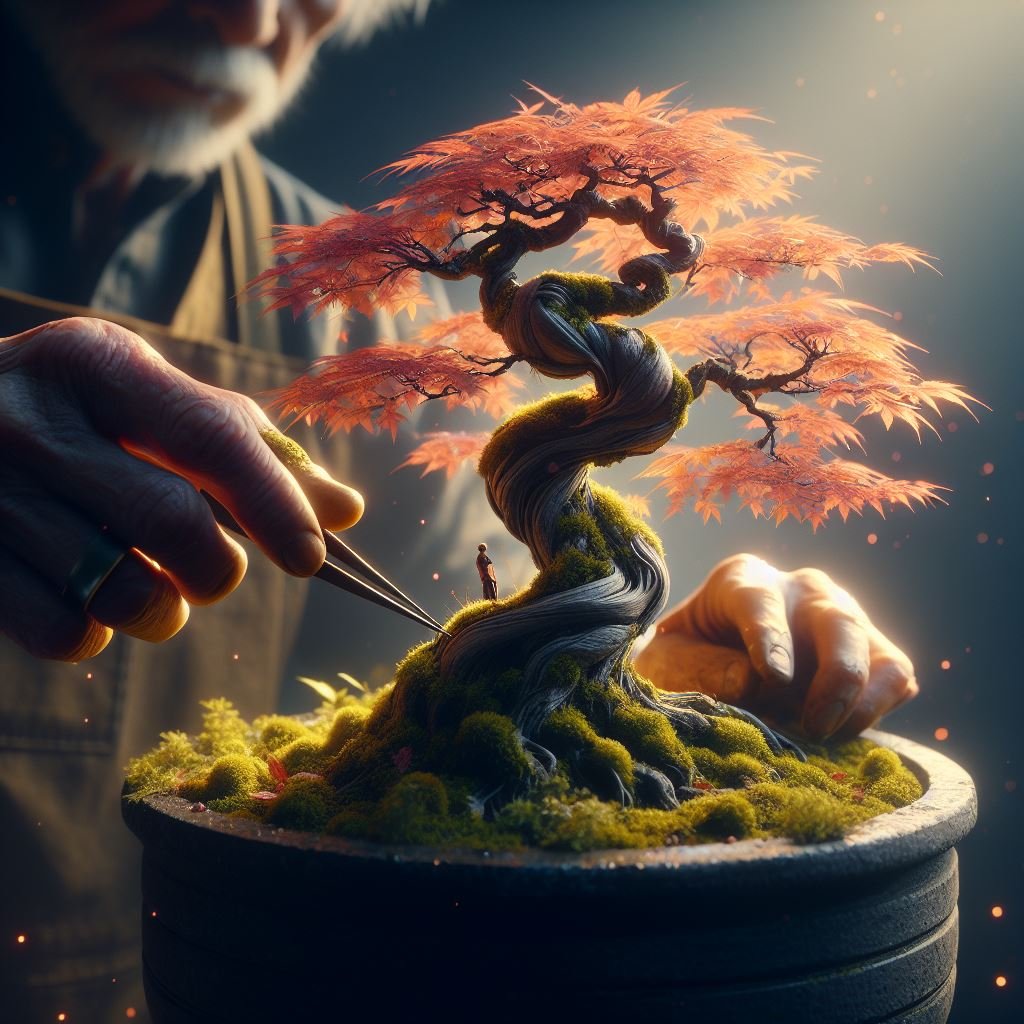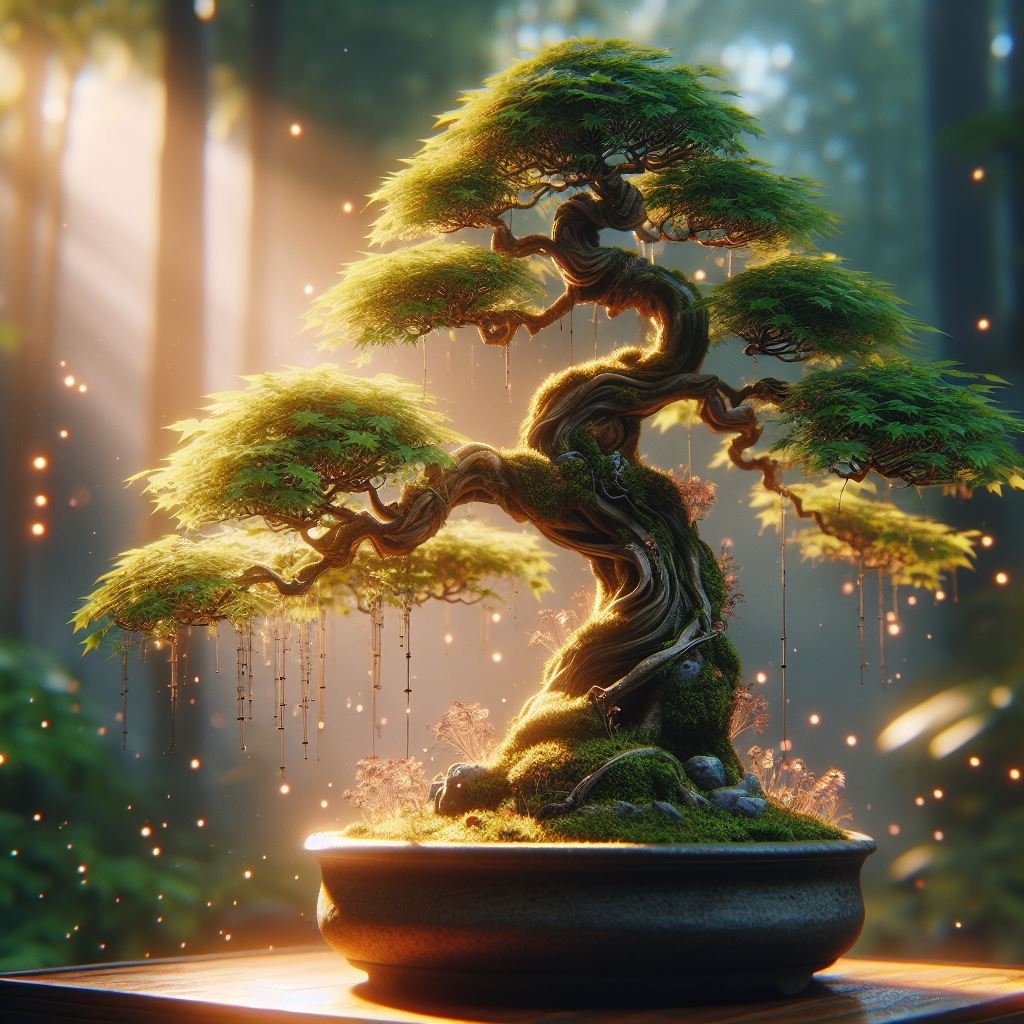Immerse yourself in the captivating world of bonsai cultivation, focusing particularly on the unique and hardy vine maple Bonsai. This Acer Circinatum variety is a large shrub that can grow between five to eight meters tall, making it an excellent choice for bonsai. The vine maple bonsai is not just another plant; it’s a living sculpture, a piece of art combined with science. Dive into the intricacies of nurturing this beautiful specimen, understanding its needs, and uncovering its potential to become a miniature masterpiece.
Introduction
The art of bonsai is a captivating pursuit, encompassing horticulture, aesthetics, and patience. Of the many plant species used in this ancient practice, the vine maple, scientifically known as Acer circinatum, stands out for its unique characteristics and potential for beauty.
Native to western North America, the vine maple is a large shrub or small tree that typically grows between five to eight meters tall. In the wild, it’s found in landscapes ranging from shady forest understories to sunny riverbanks, demonstrating its adaptability.

As a bonsai, the vine maple offers enthusiasts an opportunity to cultivate a miniature version of this hardy plant. Its leaves, which change color with the seasons, provide a stunning visual display, while its natural growth pattern lends itself well to various bonsai styles. Furthermore, the vine maple is relatively resilient and can withstand the rigors of bonsai cultivation, making it an excellent choice for both beginners and experienced practitioners.
The vine maple bonsai is not just a plant; it’s a living piece of art. It embodies the essence of bonsai – the harmony between nature, cultivation, and human intervention. Cultivating a vine maple bonsai requires understanding its needs and traits, and this guide will provide you with the necessary knowledge and insights to nurture your own vine maple bonsai successfully.
Understanding the Vine Maple Bonsai
The vine maple, or Acer circinatum, belongs to the Sapindaceae family and is native to the cool, moist forests of the Pacific Northwest in North America. As a member of the Palmata series, it shares a close relationship with another popular bonsai species, the Acer palmatum, known as the Japanese maple.
Scientific Classification
- Kingdom: Plantae
- Order: Sapindales
- Family: Sapindaceae
- Genus: Acer
- Species: A. circinatum
Origin
The vine maple originates from the west coast of North America, spanning from southern British Columbia to northern California. Its natural habitat ranges from sea level to mid-mountain elevations, highlighting its adaptability to different climates and terrains.
Physical Characteristics and Growth Pattern
Vine maples are deciduous, meaning they shed their leaves annually. They are renowned for their beautiful, broad, palate leaves that change color from green in spring and summer to vibrant shades of yellow, orange, and red in autumn. These trees have a multi-stemmed growth pattern and can reach heights of 5-8 meters in their natural environment.
The bark of the vine maple is smooth and reddish-brown, providing a striking contrast against its foliage. This species is also known for its unusual growth habit, where the branches grow outwards before arching downwards, often rooting where they touch the ground.
Place in the Series Palmata and Relationship to Acer Palmatum
The vine maple belongs to the series Palmata, a group of maple species characterized by their palmate leaves. Acer palmatum, or the Japanese maple, is also part of this series. These two species share similarities in leaf shape, growth habits, and love for cool, humid environments. However, they differ in their tolerance to harsh conditions, with the vine maple being notably hardier. This resilience makes the vine maple an excellent choice for bonsai cultivation, particularly for those living in cooler climates or beginners still developing their bonsai care skills.
Cultivation and Care for Vine Maple Bonsai
Cultivating a vine maple bonsai requires attention and care, but its hardy nature makes it forgiving to beginners. Here are the key aspects you need to consider:

Ideal Climate and Environmental Conditions
Vine maples thrive in cool, moist environments similar to their native Pacific Northwest habitat. They can tolerate a range of conditions, from full sun to partial shade, but they prefer locations with dappled sunlight. During particularly hot periods, it’s recommended to provide some shade to prevent leaf scorch.
Soil Requirements and Repotting Schedule
A well-draining soil mixture is essential for vine maple bonsai to prevent root rot. A mix of akadama, pumice, and organic potting compost in a 2:1:1 ratio is often recommended. Younger trees should be repotted every two years, while older trees can be repotted every three to five years. The best time to repot is in early spring when the tree is still dormant.
Watering, Feeding, and Sunlight Requirements
Vine maple bonsai needs consistent watering to keep the soil slightly moist but not waterlogged. The frequency will depend on the climate, the size of the pot, and the tree’s growth stage. Generally, watering once daily during growing season and reducing in winter works well.
Feeding should be done during the growing season (spring to early autumn). Use a balanced bonsai fertilizer and follow the manufacturer’s instructions. It’s advisable to reduce feeding as autumn approaches to let the tree prepare for dormancy.
As for sunlight, vine maples can adapt to various light conditions. However, they prefer a location with morning sun and afternoon shade to protect them from the harsh afternoon sun, especially in hotter climates.
Remember, every tree is unique, and what works for one may not work for another. It’s crucial to monitor your vine maple bonsai regularly and adjust your care routine as necessary.
Pruning and Styling Techniques
Pruning and styling are essential aspects of bonsai cultivation, enhancing the plant’s aesthetic appeal and promoting its health.
The Importance of Short Inter-node Pruning
Inter-node pruning refers to the practice of trimming the branches between two nodes (the points which leaves or branches grow out from). For vine maple bonsai, maintaining short inter-nodes is important because it helps to create a sense of scale and proportion in the miniature tree.
By keeping the distance between nodes short, you encourage denser foliage and a more compact growth pattern, which enhances the tree’s overall appearance. It also allows better control over the tree’s shape and direction of growth. Short inter-node pruning is typically done during the growing season but always ensure that the tree is healthy before undertaking any significant pruning.
Styling Methods Like the Vine Maple Tower
The Vine Maple Tower is a popular styling method for vine maple bonsai due to the species’ natural tendency for upward and outward growth. This style involves training the trunk and branches to grow vertically, creating a tower-like appearance.
To achieve this look, start by selecting a strong, upright stem as the main trunk. Then, prune away competing stems and unwanted branches, leaving only those necessary for the design. Wire the branches to guide their growth and create the desired form.
Remember, patience is key in bonsai styling. The Vine Maple Tower look will take time to achieve as the tree needs time to grow and adapt to the desired shape. Always approach pruning and wiring with care to avoid damaging your precious bonsai.
Styling a bonsai is an art form – it’s a way to express your creativity while respecting the tree’s natural growth habits. With careful attention and regular care, your vine maple bonsai can become a captivating miniature representation of nature’s grandeur.
Common Challenges and Solutions
Like all plants, vine maple bonsais may face challenges in terms of diseases, pests, and cultivation issues. Here are some common problems and their remedies:

Diseases and Pests Common to Vine Maple Bonsai
- Aphids: These small, sap-sucking insects can cause the leaves to curl and stunt growth. They can be controlled using a mild insecticidal soap or a strong spray of water to dislodge them from the plant.
- Powdery Mildew: This fungus appears as a white powdery substance on the leaves and stems. It usually occurs due to poor air circulation or high humidity. Improve air circulation around your bonsai, reduce watering, and consider using a fungicide if the infection is severe.
- Verticillium Wilt: This soil-borne fungus causes wilting and yellowing of leaves, often leading to the death of the plant. Unfortunately, there’s no cure for this disease. Prevent it by ensuring good drainage and not over-watering.
Overcoming Cultivation Challenges:
- Leaf Scorch: This happens when the leaves dry out and turn brown, usually due to excessive sunlight or lack of water. To prevent this, ensure your bonsai gets adequate water and protect it from harsh afternoon sun.
- Root Rot: Overwatering or poor drainage can lead to root rot. Always ensure that your bonsai pot has excellent drainage, and avoid letting the plant sit in water.
- Winter Damage: While vine maples are hardy, they can still suffer from winter damage if the temperatures drop too low. Protect your bonsai during harsh winters by moving it to a sheltered location or using a winter cover.
Remember that prevention is better than cure. Regular inspection of your bonsai can help you spot potential problems early and take necessary action before they escalate. Moreover, providing optimal growing conditions for your vine maple bonsai will go a long way in keeping it healthy and thriving.
Conclusion
Cultivating a vine maple bonsai is a rewarding endeavor that combines the arts of gardening and sculpture. While this plant may present its own set of challenges, with careful attention to watering, feeding, sunlight, pruning, and styling techniques, you can nurture a thriving bonsai. By understanding potential diseases, pests, and cultivation issues, you can prevent or address these challenges effectively. Remember that the key to successful bonsai cultivation is patience and consistent care. Over time, your efforts will be rewarded with a stunningly detailed, miniature representation of nature’s majesty.
Frequently Asked Questions (FAQs)
1. Can I grow a vine maple bonsai from seed?
Yes, you can grow a vine maple bonsai from seed, but it requires patience as it can take many years to develop into a mature bonsai tree.
2. How often should I water my vine maple bonsai?
The frequency of watering can depend on several factors, including the size of the tree and pot, the type of soil, and the climate. As a general rule, it’s best to water when the top inch of soil feels dry to the touch.
3. Is it necessary to use a fertilizer for my vine maple bonsai?
Yes, fertilizing is an essential part of bonsai care. It helps replenish the nutrients in the soil, promoting healthy growth and development.
4. How can I prevent pests and diseases in my vine maple bonsai?
Regular inspection, adequate watering, good air circulation, and proper feeding can help prevent most pest and disease issues. If you notice any problems, take action immediately to control them.
5. What should I do if the leaves of my vine maple bonsai start turning yellow?
Yellowing leaves could be a sign of overwatering, lack of nutrients, or a disease. Identify the root cause and make necessary adjustments in your care routine. If the problem persists, consider seeking advice from a bonsai expert.






This is really interesting, You’re a very skilled blogger. I’ve joined your feed and look forward to seeking more of your magnificent post. Also, I’ve shared your site in my social networks!